+ Open data
Open data
- Basic information
Basic information
| Entry | Database: EMDB / ID: EMD-30005 | |||||||||||||||||||||
|---|---|---|---|---|---|---|---|---|---|---|---|---|---|---|---|---|---|---|---|---|---|---|
| Title | pri-miRNA bound DROSHA-DGCR8 complex | |||||||||||||||||||||
 Map data Map data | ||||||||||||||||||||||
 Sample Sample |
| |||||||||||||||||||||
 Keywords Keywords | Ribonuclease / RNA BINDING PROTEIN / HYDROLASE-RNA BINDING PROTEIN-RNA complex | |||||||||||||||||||||
| Function / homology |  Function and homology information Function and homology informationpositive regulation of pre-miRNA processing / microprocessor complex / regulation of miRNA metabolic process / protein-RNA adaptor activity / DEAD/H-box RNA helicase binding / primary miRNA binding / ribonuclease III / Transcriptional Regulation by MECP2 / regulation of regulatory T cell differentiation / primary miRNA processing ...positive regulation of pre-miRNA processing / microprocessor complex / regulation of miRNA metabolic process / protein-RNA adaptor activity / DEAD/H-box RNA helicase binding / primary miRNA binding / ribonuclease III / Transcriptional Regulation by MECP2 / regulation of regulatory T cell differentiation / primary miRNA processing / miRNA metabolic process / regulation of stem cell proliferation / ribonuclease III activity / pre-miRNA processing / MicroRNA (miRNA) biogenesis / SMAD binding / R-SMAD binding / lipopolysaccharide binding / rRNA processing / double-stranded RNA binding / site of double-strand break / regulation of inflammatory response / protein-macromolecule adaptor activity / defense response to Gram-negative bacterium / defense response to Gram-positive bacterium / postsynaptic density / nuclear body / heme binding / DNA damage response / positive regulation of gene expression / nucleolus / glutamatergic synapse / protein homodimerization activity / RNA binding / nucleoplasm / metal ion binding / identical protein binding / nucleus / cytosol / cytoplasm Similarity search - Function | |||||||||||||||||||||
| Biological species |  Homo sapiens (human) Homo sapiens (human) | |||||||||||||||||||||
| Method | single particle reconstruction / cryo EM / Resolution: 3.9 Å | |||||||||||||||||||||
 Authors Authors | Jin W / Wang J | |||||||||||||||||||||
| Funding support |  China, 6 items China, 6 items
| |||||||||||||||||||||
 Citation Citation |  Journal: Mol Cell / Year: 2020 Journal: Mol Cell / Year: 2020Title: Structural Basis for pri-miRNA Recognition by Drosha. Authors: Wenxing Jin / Jia Wang / Chao-Pei Liu / Hong-Wei Wang / Rui-Ming Xu /  Abstract: A commencing and critical step in miRNA biogenesis involves processing of pri-miRNAs in the nucleus by Microprocessor. An important, but not completely understood, question is how Drosha, the ...A commencing and critical step in miRNA biogenesis involves processing of pri-miRNAs in the nucleus by Microprocessor. An important, but not completely understood, question is how Drosha, the catalytic subunit of Microprocessor, binds pri-miRNAs and correctly specifies cleavage sites. Here we report the cryoelectron microscopy structures of the Drosha-DGCR8 complex with and without a pri-miRNA. The RNA-bound structure provides direct visualization of the tertiary structure of pri-miRNA and shows that a helix hairpin in the extended PAZ domain and the mobile basic (MB) helix in the RNase IIIa domain of Drosha coordinate to recognize the single-stranded to double-stranded junction of RNA, whereas the dsRNA binding domain makes extensive contacts with the RNA stem. Furthermore, the RNA-free structure reveals an autoinhibitory conformation of the PAZ helix hairpin. These findings provide mechanistic insights into pri-miRNA cleavage site selection and conformational dynamics governing pri-miRNA recognition by the catalytic component of Microprocessor. | |||||||||||||||||||||
| History |
|
- Structure visualization
Structure visualization
| Movie |
 Movie viewer Movie viewer |
|---|---|
| Structure viewer | EM map:  SurfView SurfView Molmil Molmil Jmol/JSmol Jmol/JSmol |
| Supplemental images |
- Downloads & links
Downloads & links
-EMDB archive
| Map data |  emd_30005.map.gz emd_30005.map.gz | 1.9 MB |  EMDB map data format EMDB map data format | |
|---|---|---|---|---|
| Header (meta data) |  emd-30005-v30.xml emd-30005-v30.xml emd-30005.xml emd-30005.xml | 15.3 KB 15.3 KB | Display Display |  EMDB header EMDB header |
| Images |  emd_30005.png emd_30005.png | 95.5 KB | ||
| Filedesc metadata |  emd-30005.cif.gz emd-30005.cif.gz | 7 KB | ||
| Archive directory |  http://ftp.pdbj.org/pub/emdb/structures/EMD-30005 http://ftp.pdbj.org/pub/emdb/structures/EMD-30005 ftp://ftp.pdbj.org/pub/emdb/structures/EMD-30005 ftp://ftp.pdbj.org/pub/emdb/structures/EMD-30005 | HTTPS FTP |
-Validation report
| Summary document |  emd_30005_validation.pdf.gz emd_30005_validation.pdf.gz | 347.8 KB | Display |  EMDB validaton report EMDB validaton report |
|---|---|---|---|---|
| Full document |  emd_30005_full_validation.pdf.gz emd_30005_full_validation.pdf.gz | 347.4 KB | Display | |
| Data in XML |  emd_30005_validation.xml.gz emd_30005_validation.xml.gz | 5.5 KB | Display | |
| Data in CIF |  emd_30005_validation.cif.gz emd_30005_validation.cif.gz | 6.2 KB | Display | |
| Arichive directory |  https://ftp.pdbj.org/pub/emdb/validation_reports/EMD-30005 https://ftp.pdbj.org/pub/emdb/validation_reports/EMD-30005 ftp://ftp.pdbj.org/pub/emdb/validation_reports/EMD-30005 ftp://ftp.pdbj.org/pub/emdb/validation_reports/EMD-30005 | HTTPS FTP |
-Related structure data
| Related structure data |  6lxdMC  6lxeC M: atomic model generated by this map C: citing same article ( |
|---|---|
| Similar structure data |
- Links
Links
| EMDB pages |  EMDB (EBI/PDBe) / EMDB (EBI/PDBe) /  EMDataResource EMDataResource |
|---|---|
| Related items in Molecule of the Month |
- Map
Map
| File |  Download / File: emd_30005.map.gz / Format: CCP4 / Size: 22.2 MB / Type: IMAGE STORED AS FLOATING POINT NUMBER (4 BYTES) Download / File: emd_30005.map.gz / Format: CCP4 / Size: 22.2 MB / Type: IMAGE STORED AS FLOATING POINT NUMBER (4 BYTES) | ||||||||||||||||||||||||||||||||||||||||||||||||||||||||||||||||||||
|---|---|---|---|---|---|---|---|---|---|---|---|---|---|---|---|---|---|---|---|---|---|---|---|---|---|---|---|---|---|---|---|---|---|---|---|---|---|---|---|---|---|---|---|---|---|---|---|---|---|---|---|---|---|---|---|---|---|---|---|---|---|---|---|---|---|---|---|---|---|
| Projections & slices | Image control
Images are generated by Spider. | ||||||||||||||||||||||||||||||||||||||||||||||||||||||||||||||||||||
| Voxel size | X=Y=Z: 1.35 Å | ||||||||||||||||||||||||||||||||||||||||||||||||||||||||||||||||||||
| Density |
| ||||||||||||||||||||||||||||||||||||||||||||||||||||||||||||||||||||
| Symmetry | Space group: 1 | ||||||||||||||||||||||||||||||||||||||||||||||||||||||||||||||||||||
| Details | EMDB XML:
CCP4 map header:
| ||||||||||||||||||||||||||||||||||||||||||||||||||||||||||||||||||||
-Supplemental data
- Sample components
Sample components
-Entire : Ternary complex of DROSHA-DGCR8 with pri-16-1m RNA
| Entire | Name: Ternary complex of DROSHA-DGCR8 with pri-16-1m RNA |
|---|---|
| Components |
|
-Supramolecule #1: Ternary complex of DROSHA-DGCR8 with pri-16-1m RNA
| Supramolecule | Name: Ternary complex of DROSHA-DGCR8 with pri-16-1m RNA / type: complex / ID: 1 / Parent: 0 / Macromolecule list: #1-#3 |
|---|---|
| Source (natural) | Organism:  Homo sapiens (human) Homo sapiens (human) |
-Macromolecule #1: Ribonuclease 3
| Macromolecule | Name: Ribonuclease 3 / type: protein_or_peptide / ID: 1 / Number of copies: 1 / Enantiomer: LEVO / EC number: ribonuclease III |
|---|---|
| Source (natural) | Organism:  Homo sapiens (human) Homo sapiens (human) |
| Molecular weight | Theoretical: 115.390578 KDa |
| Recombinant expression | Organism:  |
| Sequence | String: EPEETMPDKN EEEEEELLKP VWIRCTHSEN YYSSDPMDQV GDSTVVGTSR LRDLYDKFEE ELGSRQEKAK AARPPWEPPK TKLDEDLES SSESECESDE DSTCSSSSDS EVFDVIAEIK RKKAHPDRLH DELWYNDPGQ MNDGPLCKCS AKARRTGIRH S IYPGEEAI ...String: EPEETMPDKN EEEEEELLKP VWIRCTHSEN YYSSDPMDQV GDSTVVGTSR LRDLYDKFEE ELGSRQEKAK AARPPWEPPK TKLDEDLES SSESECESDE DSTCSSSSDS EVFDVIAEIK RKKAHPDRLH DELWYNDPGQ MNDGPLCKCS AKARRTGIRH S IYPGEEAI KPCRPMTNNA GRLFHYRITV SPPTNFLTDR PTVIEYDDHE YIFEGFSMFA HAPLTNIPLC KVIRFNIDYT IH FIEEMMP ENFCVKGLEL FSLFLFRDIL ELYDWNLKGP LFEDSPPCCP RFHFMPRFVR FLPDGGKEVL SMHQILLYLL RCS KALVPE EEIANMLQWE ELEWQKYAEE CKGMIVTNPG TKPSSVRIDQ LDREQFNPDV ITFPIIVHFG IRPAQLSYAG DPQY QKLWK SYVKLRHLLA NSPKVKQTDK QKLAQREEAL QKIRQKNTMR REVTVELSSQ GFWKTGIRSD VCQHAMMLPV LTHHI RYHQ CLMHLDKLIG YTFQDRCLLQ LAMTHPSHHL NFGMNPDHAR NSLSNCGIRQ PKYGDRKVHH MHMRKKGINT LINIMS RLG QDDPTPSRIN HNERLEFLGD AVVEFLTSVH LYYLFPSLEE GGLATYRTAI VQNQHLAMLA KKLELDRFML YAHGPDL CR ESDLRHAMAN CFQALIGAVY LEGSLEEAKQ LFGRLLFNDP DLREVWLNYP LHPLQLQEPN TDRQLIETSP VLQKLTEF E EAIGVIFTHV RLLARAFTLR TVGFNHLTLG HNQRMEFLGD SIMQLVATEY LFIHFPDHHE GHLTLLRSSL VNNRTQAKV AEELGMQEYA ITNDKTKRPV ALRTKTLADL LQSFIAALYI DKDLEYVHTF MNVCFFPRLK EFILNQDWND PKSQLQQCCL TLRTEGKEP DIPLYKTLQT VGPSHARTYT VAVYFKGERI GCGKGPSIQQ AEMGAAMDAL EKYNFPQMAH QKRFIERKYR Q ELKEMRWE REHQEREPDE TEDIKKHHHH HH UniProtKB: Ribonuclease 3 |
-Macromolecule #2: Microprocessor complex subunit DGCR8
| Macromolecule | Name: Microprocessor complex subunit DGCR8 / type: protein_or_peptide / ID: 2 / Number of copies: 2 / Enantiomer: LEVO |
|---|---|
| Source (natural) | Organism:  Homo sapiens (human) Homo sapiens (human) |
| Molecular weight | Theoretical: 86.171203 KDa |
| Recombinant expression | Organism:  |
| Sequence | String: METDESPSPL PCGPAGEAVM ESRARPFQAL PREQSPPPPL QTSSGAEVMD VGSGGDGQSE LPAEDPFNFY GASLLSKGSF SKGRLLIDP NCSGHSPRTA RHAPAVRKFS PDLKLLKDVK ISVSFTESCR SKDRKVLYTG AERDVRAECG LLLSPVSGDV H ACPFGGSV ...String: METDESPSPL PCGPAGEAVM ESRARPFQAL PREQSPPPPL QTSSGAEVMD VGSGGDGQSE LPAEDPFNFY GASLLSKGSF SKGRLLIDP NCSGHSPRTA RHAPAVRKFS PDLKLLKDVK ISVSFTESCR SKDRKVLYTG AERDVRAECG LLLSPVSGDV H ACPFGGSV GDGVGIGGES ADKKDEENEL DQEKRVEYAV LDELEDFTDN LELDEEGAGG FTAKAIVQRD RVDEEALNFP YE DDFDNDV DALLEEGLCA PKKRRTEEKY GGDSDHPSDG ETSVQPMMTK IKTVLKSRGR PPTEPLPDGW IMTFHNSGVP VYL HRESRV VTWSRPYFLG TGSIRKHDPP LSSIPCLHYK KMKDNEEREQ SSDLTPSGDV SPVKPLSRSA ELEFPLDEPD SMGA DPGPP DEKDPLGAEA APGALGQVKA KVEVCKDESV DLEEFRSYLE KRFDFEQVTV KKFRTWAERR QFNREMKRKQ AESER PILP ANQKLITLSV QDAPTKKEFV INPNGKSEVC ILHEYMQRVL KVRPVYNFFE CENPSEPFGA SVTIDGVTYG SGTASS KKL AKNKAARATL EILIPDFVKQ TSEEKPKDSE ELEYFNHISI EDSRVYELTS KAGLLSPYQI LHECLKRNHG MGDTSIK FE VVPGKNQKSE YVMACGKHTV RGWCKNKRVG KQLASQKILQ LLHPHVKNWG SLLRMYGRES SKMVKQETSD KSVIELQQ Y AKKNKPNLHI LSKLQEEMKR LAEEREETRK KPKMSIVASA QPGGEPLCTV DV UniProtKB: Microprocessor complex subunit DGCR8 |
-Macromolecule #3: RNA (102-mer)
| Macromolecule | Name: RNA (102-mer) / type: rna / ID: 3 / Number of copies: 1 |
|---|---|
| Source (natural) | Organism:  Homo sapiens (human) Homo sapiens (human) |
| Molecular weight | Theoretical: 32.759398 KDa |
| Sequence | String: GGUGAUAGCA AUGUCAGCAG UGCCUUAGCA GCACGUAAAU AUUGGCCAUU GCACUCCGGC CAGUAUUAAC UGUGCUGCUG AAGUAAGGU UGACCAUACU CUA |
-Macromolecule #4: ZINC ION
| Macromolecule | Name: ZINC ION / type: ligand / ID: 4 / Number of copies: 2 / Formula: ZN |
|---|---|
| Molecular weight | Theoretical: 65.409 Da |
-Experimental details
-Structure determination
| Method | cryo EM |
|---|---|
 Processing Processing | single particle reconstruction |
| Aggregation state | particle |
- Sample preparation
Sample preparation
| Concentration | 0.3 mg/mL |
|---|---|
| Buffer | pH: 8 |
| Grid | Model: Quantifoil R1.2/1.3 / Material: GOLD / Mesh: 300 / Pretreatment - Type: GLOW DISCHARGE / Pretreatment - Time: 30 sec. / Pretreatment - Atmosphere: AIR |
| Vitrification | Cryogen name: ETHANE / Chamber humidity: 100 % / Instrument: FEI VITROBOT MARK IV |
- Electron microscopy
Electron microscopy
| Microscope | FEI TITAN KRIOS |
|---|---|
| Image recording | Film or detector model: GATAN K2 SUMMIT (4k x 4k) / Average electron dose: 50.0 e/Å2 |
| Electron beam | Acceleration voltage: 300 kV / Electron source:  FIELD EMISSION GUN FIELD EMISSION GUN |
| Electron optics | C2 aperture diameter: 50.0 µm / Illumination mode: FLOOD BEAM / Imaging mode: BRIGHT FIELD / Cs: 2.7 mm |
| Experimental equipment |  Model: Titan Krios / Image courtesy: FEI Company |
- Image processing
Image processing
| Startup model | Type of model: OTHER |
|---|---|
| Final reconstruction | Number classes used: 1 / Applied symmetry - Point group: C1 (asymmetric) / Algorithm: FOURIER SPACE / Resolution.type: BY AUTHOR / Resolution: 3.9 Å / Resolution method: FSC 0.143 CUT-OFF / Software - Name: RELION (ver. 3.0) / Number images used: 250943 |
| Initial angle assignment | Type: MAXIMUM LIKELIHOOD |
| Final angle assignment | Type: MAXIMUM LIKELIHOOD |
 Movie
Movie Controller
Controller



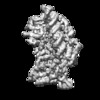



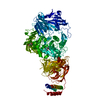
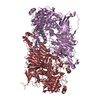
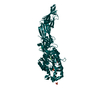
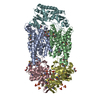









 Z (Sec.)
Z (Sec.) Y (Row.)
Y (Row.) X (Col.)
X (Col.)






















